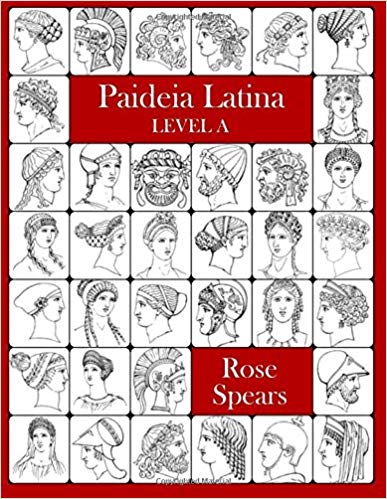Paideia Latina can be used in both classroom and homeschool situations. The target audience is grades four through six, but it should be equally effective with junior high students who need an introduction to Latin that is less intense than most Latin courses for that level.
Level A and Level B each take one year to complete. My review focuses on Level A.
This grammar-based course covers first and second-declension nouns and adjectives (all five case endings) plus first- and second-conjugation verbs (present, imperfect, and future tenses). While all five case endings are taught for nouns and adjectives, translation work deals only with the nominative, accusative, and ablative cases.
The course consists of a teacher’s edition and a student book. The teacher’s book has pages very similar to the student pages but with answers filled in on worksheets. The teacher’s book adds two pages at the beginning that introduce the course, a large section of weekly quizzes, cumulative review quizzes, a final exam, and answer keys for all of these. Both books have reference material at the back with charts of the paradigms learned in the course, an English-to-Latin glossary, and a Latin-to-English glossary.
There are lessons for 33 weeks, with a review lesson after every five lessons and comprehensive cumulative reviews for the last two weeks. Review lessons challenge students on their mastery of vocabulary words introduced in the last five lessons, present a crossword puzzle, and provide a variety of exercises such as filling in charts, filling in blanks in sentences, and translating words, phrases, or sentences.
Lesson instruction is written within the lessons in both teacher and student books under the heading Grammar Lessons. Capable students might work independently through the Grammar Lessons.
Lessons for each week (other than review weeks) begin with an introduction of new Latin vocabulary words, including their phonetic pronunciations and definitions. The course teaches ecclesiastical pronunciation, explaining it in the first lesson.
After the vocabulary, charts show some of the lesson content to be learned each week. Charts are explained within the Grammar Lessons along with other instruction. Charts, labeled as “Chants,” show declensions, verb conjugations, and singulars and plurals. The course seems to leave it to the teacher to decide whether or not to have students practice the chants orally, so I checked with the author. She says,
The students should be able to chant through them quickly out loud, but they also need to be able to write them down with the endings spelled correctly. I recommend the teacher/parent having the student say/chant the vocabulary and chants every day out loud before working on the workbook pages.
Grammar concepts are learned as short statements which are then practiced orally in the Grammar Sound Off section. Students learn to respond to the beginning of each grammar concept with the rest of the statement. For example, the first part of the Grammar Sound Off might be “words that end in ‘-us’…” and the student responds “…are mostly masculine.”
The remainder of each lesson consists of worksheets and exercises which vary from week to week. Students fill in charts with the missing verb, noun, or adjective forms. They fill in blanks to complete statements from the Grammar Sound Off or to reinforce vocabulary. Some exercises include multiple-choice questions. Students also practice changing Latin word endings and matching up columns to show correct endings. Occasionally, students identify English derivatives of Latin words. Translation practice includes translating words, phrases, and complete sentences from Latin into English, but translating only words and phrases from English into Latin since this is more challenging.
Each lesson concludes with a brief story for students to read aloud. In the first few lessons, these stories are written in English with just a few Latin words woven into the stories for students to translate into English as they read. The context makes this relatively easy. Gradually, a higher percentage of Latin words is woven into each story. The last few stories are written entirely in Latin.
The course has occasional Christian content, and each lesson includes a brief, illustrated segment on Roman or Greek mythology. Christian content, though minimal, shows up in the exercises and translation work and cannot easily be skipped, but the mythology material can be skipped if you wish.
Paideia Latina is easy to use, even for the parent or teacher who doesn’t already know Latin. However, there are no obvious stop-and-start points within a week’s lesson. So I asked the author for clarification regarding how much work to complete each day. She responded:
There are usually four pages per week to complete in the workbook. I would do five days a week of lessons.
Monday - read through vocabulary/chant and introduce the grammar lesson; do one page of the worksheets.
Tuesday, Wednesday, and Thursday: read through vocabulary/chant, review the grammar sound off, and do one page of the worksheets.
Friday - take quiz.
Summary
I find the convenience of having worksheets directly within the lessons to be very helpful. In addition, the variety of the exercises on the worksheets should make the course interesting for students. Instruction progresses at a very manageable pace that should work for most students as they learn many Latin vocabulary words and the foundations of Latin grammar. Students who complete this course should be well prepared to breeze through the first part of a first-year high school Latin course.












